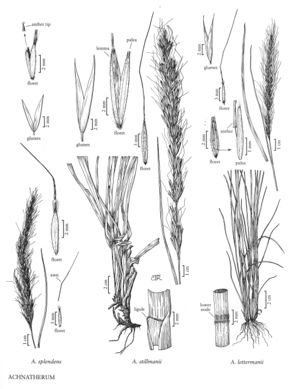Achnatherum stillmanii
Plants shortly rhizomatous, forming open clumps. Culms 60-150 cm tall, 2-5 mm thick, often geniculate at the lowest node, mostly glabrous; nodes 2-3, often puberulent. Basal sheaths mostly glabrous, some¬times ciliate distally, intact at maturity; collars glabrous or pubescent, often with hairs at the sides, hairs shorter than 0.5 mm; basal ligules 0.2-0.5 mm, membranous, truncate, ciliate, cilia 0.2-0.3 mm; upper ligules shorter than the basal ligules; blades 3-7 mm wide, lax. Panicles 10-24 cm long, 1.5-3 cm wide, contracted; branches straight, appressed to strongly ascending, lower branches 2.5-3.5 cm. Spikelets appressed to the branches. Glumes subequal, 14-16 mm; lower glumes 1-3-veined; upper glumes 0.6-1.5 mm wide, 3-5-veined; florets 8-10 mm, fusiform; calluses 0.5-1.2 mm, rounded; lemmas evenly hairy, hairs about 0.5 mm, apical hairs similar in length, apices 2-lobed, lobes 1-3 mm, narrow; awns 18-25 mm, persistent, scabrous, once- or twice-geniculate, terminal segment straight; paleas as long as or slightly longer than the lemmas, hairy, hairs about 0.5 mm, veins prolonged, reaching almost to the tips of the lemma lobes; anthers 4-6 mm, penicillate, dehiscent. Caryopses fusiform. 2n = unknown.
Distribution
Calif.
Discussion
Achnatherum stillmanii grows at scattered locations in coniferous forests in northern California, at 900-1500 m, possibly being edaphically restricted. Its combination of large size, long, narrow lemma lobes, and paleal morphology distinguish A. stillmanii from all other North American species of Achnatherum.
Selected References
None.
